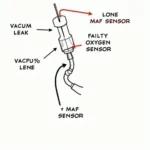The OBD2 code B1516 indicates a malfunction within your vehicle’s climate control system, specifically related to the blower motor circuit. When this code appears, it signifies that the Engine Control Module (ECM), responsible for monitoring various systems including climate control, has detected an issue in the blower motor circuit, typically involving a voltage problem.
Decoding the OBD2 Code B1516
The code B1516 stands for “A/C Blower Motor Circuit Range/Performance.” This points to a problem with the electrical circuit that powers your A/C blower motor, the component responsible for pushing air through your vehicle’s vents. The “Range/Performance” part suggests an inconsistency in the voltage signal being sent to the motor or received from it. This inconsistency can lead to weak airflow, intermittent blower operation, or a complete blower motor failure.
Common Causes of OBD2 Code B1516
While a faulty blower motor is a possible culprit, several other factors can trigger the B1516 code:
- Faulty Blower Motor Resistor: The resistor regulates the blower motor speed by adjusting the voltage supplied to the motor. A malfunctioning resistor can disrupt the voltage flow and trigger the code.
- Damaged Wiring or Connectors: Worn-out, corroded, or loose wiring and connectors within the blower motor circuit can hinder proper electrical flow, leading to voltage irregularities and triggering the code.
- Malfunctioning Blower Motor Relay: The relay acts as a switch, controlling the power supply to the blower motor. A faulty relay can interrupt the circuit and prevent the motor from receiving adequate power.
- Faulty Climate Control Module: In some cases, the issue might lie within the climate control module itself, responsible for sending signals to the blower motor. A malfunctioning module can send incorrect signals, leading to operational errors and triggering the code.
Diagnosing and Fixing the B1516 Code
Accurately diagnosing the root cause of the B1516 code requires a systematic approach. Here’s a step-by-step guide:
- Read the Code: Use an OBD2 scanner to read the error code stored in your vehicle’s ECM.
- Inspect the Blower Motor: Check for any visible damage to the blower motor itself. Ensure it spins freely and doesn’t exhibit any unusual noises when manually rotated.
- Test the Blower Motor Resistor: Locate the resistor (usually near the blower motor) and test its resistance using a multimeter. A faulty resistor will show inconsistent or out-of-range readings.
- Examine the Wiring and Connectors: Thoroughly inspect the wiring harness and connectors within the blower motor circuit for any signs of damage, corrosion, or looseness.
- Check the Blower Motor Relay: Locate the relay (often found in the fuse box) and test it for continuity using a multimeter. Replace the relay if it fails the continuity test.
- Inspect the Climate Control Module: If all other components check out, the issue might reside within the climate control module. Consult a qualified mechanic for further diagnosis and potential module replacement.
Importance of Addressing OBD2 Code B1516
Ignoring the B1516 code can lead to discomfort, potential safety hazards, and even costlier repairs in the long run. A malfunctioning blower motor can impact your vehicle’s defroster, reducing visibility during cold or humid conditions. Moreover, a completely failed blower motor can strain other climate control components, leading to more extensive and expensive repairs.
“Addressing the B1516 code promptly ensures a comfortable cabin environment and prevents further damage to your vehicle’s climate control system,” says John Miller, a veteran automotive electrician with over 20 years of experience. “Regular maintenance checks, including inspections of the blower motor circuit components, can prevent many of these issues from arising.”
Conclusion
Understanding the OBD2 code B1516 empowers you to address any issues with your vehicle’s blower motor circuit promptly and effectively. By following the diagnosis steps and seeking professional help when needed, you can ensure a comfortable and safe driving experience. Remember, a properly functioning climate control system is essential for both comfort and safety, making it crucial to address any issues without delay.
FAQ
Q: Can I still drive my car with the OBD2 code B1516?
A: While you might still be able to drive, it’s not recommended. Driving with a faulty blower motor circuit can impact your defroster and potentially lead to further damage to your A/C system.
Q: How much does it cost to fix the OBD2 code B1516?
A: The cost varies depending on the root cause. A simple resistor replacement might cost under $50, while a blower motor replacement can range from $150 to $500 or more.
Q: Can I fix the OBD2 code B1516 myself?
A: Basic troubleshooting like checking fuses and inspecting wiring can be done at home. However, it’s recommended to seek professional help for more complex diagnosis and repairs.


